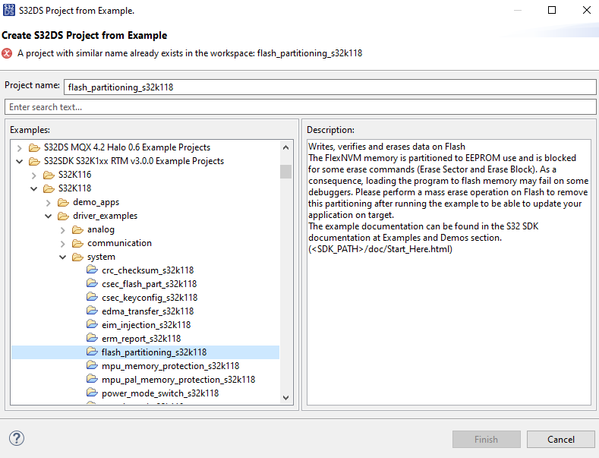- Forums
- Product Forums
- General Purpose MicrocontrollersGeneral Purpose Microcontrollers
- i.MX Forumsi.MX Forums
- QorIQ Processing PlatformsQorIQ Processing Platforms
- Identification and SecurityIdentification and Security
- Power ManagementPower Management
- MCX Microcontrollers
- S32G
- S32K
- S32V
- MPC5xxx
- Other NXP Products
- Wireless Connectivity
- S12 / MagniV Microcontrollers
- Powertrain and Electrification Analog Drivers
- Sensors
- Vybrid Processors
- Digital Signal Controllers
- 8-bit Microcontrollers
- ColdFire/68K Microcontrollers and Processors
- PowerQUICC Processors
- OSBDM and TBDML
-
- Solution Forums
- Software Forums
- MCUXpresso Software and ToolsMCUXpresso Software and Tools
- CodeWarriorCodeWarrior
- MQX Software SolutionsMQX Software Solutions
- Model-Based Design Toolbox (MBDT)Model-Based Design Toolbox (MBDT)
- FreeMASTER
- eIQ Machine Learning Software
- Embedded Software and Tools Clinic
- S32 SDK
- S32 Design Studio
- GUI Guider
- Zephyr Project
- Voice Technology
- Application Software Packs
- Secure Provisioning SDK (SPSDK)
- Processor Expert Software
- MCUXpresso Training Hub
-
- Topics
- Mobile Robotics - Drones and RoversMobile Robotics - Drones and Rovers
- NXP Training ContentNXP Training Content
- University ProgramsUniversity Programs
- Rapid IoT
- NXP Designs
- SafeAssure-Community
- OSS Security & Maintenance
- Using Our Community
-
- Cloud Lab Forums
-
- Knowledge Bases
- RSS フィードを購読する
- トピックを新着としてマーク
- トピックを既読としてマーク
- このトピックを現在のユーザーにフロートします
- ブックマーク
- 購読
- ミュート
- 印刷用ページ
- 新着としてマーク
- ブックマーク
- 購読
- ミュート
- RSS フィードを購読する
- ハイライト
- 印刷
- 不適切なコンテンツを報告
Hi
I'm trying to use EEPROM Functionality, and refer to AN11983 Rev 0,06/2017
there are examples, but I couldn't access the funcition which in the examples.
this function is flash_launchCommand();
What can I do?
And Can I get the full example code like S32K1xx Series Cookbook(AN5413)?
解決済! 解決策の投稿を見る。
- 新着としてマーク
- ブックマーク
- 購読
- ミュート
- RSS フィードを購読する
- ハイライト
- 印刷
- 不適切なコンテンツを報告
Hi,
SW examples directly for the AN11983 is not available.
However, the flash_partitioning_s32k118 example can be found in the S32DS: File -> New -> S32DS Project from Example
Another available example codes are made for the S32K144:
1. See the attachment.
To better understand flash commands I strongly recommend you reading the Reference Manual rev 12.1
The flash commands are usually launched from the RAM because some operations on the flash module cannot be executed simultaneously.
The equivalent of that function (flash_launchCommand();) can be found in the mentioned example "flash_partitioning_s32k118" function "FLASH_DRV_CommandSequence"
Or simply:
/* Clear CCIF to launch command */
FTFx_FSTAT |= FTFx_FSTAT_CCIF_MASK;
/* Wait for previous command to complete */
while ((FTFC->FSTAT & FTFC_FSTAT_CCIF_MASK) == 0);
I hope it helps,
Best regards.
Diana
- 新着としてマーク
- ブックマーク
- 購読
- ミュート
- RSS フィードを購読する
- ハイライト
- 印刷
- 不適切なコンテンツを報告
Hi,
SW examples directly for the AN11983 is not available.
However, the flash_partitioning_s32k118 example can be found in the S32DS: File -> New -> S32DS Project from Example
Another available example codes are made for the S32K144:
1. See the attachment.
To better understand flash commands I strongly recommend you reading the Reference Manual rev 12.1
The flash commands are usually launched from the RAM because some operations on the flash module cannot be executed simultaneously.
The equivalent of that function (flash_launchCommand();) can be found in the mentioned example "flash_partitioning_s32k118" function "FLASH_DRV_CommandSequence"
Or simply:
/* Clear CCIF to launch command */
FTFx_FSTAT |= FTFx_FSTAT_CCIF_MASK;
/* Wait for previous command to complete */
while ((FTFC->FSTAT & FTFC_FSTAT_CCIF_MASK) == 0);
I hope it helps,
Best regards.
Diana
- 新着としてマーク
- ブックマーク
- 購読
- ミュート
- RSS フィードを購読する
- ハイライト
- 印刷
- 不適切なコンテンツを報告
Hi
Thanks for response.
your answer is useful for me.
but, I have another question.
In the example EEEPROM no SDK, when using the write function,
the function 'EEE_Write_ByteArray' execute the line to check FSTAT_CCIF whenever it write 4 byte.
I wonder why FSTAT_CCIF have to be checked.
And When writing the mass data(is bigger than 4 byte), Can I use the memcpy function?
- 新着としてマーク
- ブックマーク
- 購読
- ミュート
- RSS フィードを購読する
- ハイライト
- 印刷
- 不適切なコンテンツを報告
Hello,
Please, refer to the AN11983 section "3.6.1 EEE writes"
"Writes to the EEE space launch a EEE operation to store the data within the E-flash memory. Because this is a flash program operation, software must test the CCIF bit to determine if any other flash operations are in progress before writing to the EEE space. Because multiple concurrent writes and read-while-write operations within the same flash block are not allowable, accesses
to the EEE or D-flash space are not allowed until the EEE write is complete. Check CCIF flag to determine if previous Flash or EEEPROM command is finished"
>> When writing the mass data(is bigger than 4 byte), Can I use the memcpy function?
No, you should wait for CCIF whenever you write 4 bytes as you can see in the example.
"the records used to back up the EEE data use a word sized data field"
I hope it helps.
Best regards,
Diana
